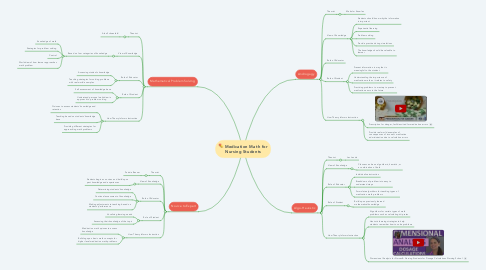
1. Mathematical Problem Solving
1.1. Theorist
1.1.1. Alan Schoenfeld
1.2. View of Knowledge
1.2.1. Based on four categories of knowledge
1.2.1.1. Knowledge of math
1.2.1.2. Strategies for problem solving
1.2.1.3. Control
1.2.1.4. Worldview of how learner approaches math problem
1.3. Role of Educator
1.3.1. Assessing student's knowledge
1.3.2. Teaching strategies for solving problems with real world examples
1.4. Role of Student
1.4.1. Self assessment of knowledge base
1.4.2. Understand personal worldview in approach to problem solving
1.5. How Theory Informs Instruction
1.5.1. Quizzes to assess students' knowledge and retention
1.5.2. Teaching based on students' knowledge base
1.5.3. Providing different strategies for approaching math problems
2. Novice to Expert
2.1. Theorist
2.1.1. Patricia Benner
2.2. View of Knowledge
2.2.1. Students begin as novices and build upon past knowledge and experiences
2.3. Role of Educator
2.3.1. Determining students' knowledge
2.3.2. Continual assessment of knowledge
2.3.3. Making adjustments to teaching based on students' performance
2.4. Role of Student
2.4.1. Vocalizing learning needs
2.4.2. Assessing their knowledge of the topic
2.5. How Theory Informs Instruction
2.5.1. Medication math quizzes to assess knowledge
2.5.2. Building upon basic math concepts for higher level medication math problems
3. Androgagy
3.1. Theorist
3.1.1. Malcolm Knowles
3.2. View of Knowledge
3.2.1. Students should know why the information is important
3.2.2. Experiential learning
3.2.3. Problem solving
3.2.4. Provide practice during simulations
3.2.5. The knowledge should be valuable to learner
3.3. Role of Educator
3.4. Role of Student
3.4.1. Present information in way that is meaningful to the student
3.4.2. Understanding the importance of medication math as it relates to safety
3.4.3. Practicing problems to mastery to prevent medication errors in the future
3.5. How Theory Informs Instruction
3.5.1. Prescription for danger, facilities cited for medication errors
3.5.2. Provide real world examples of consequences of incorrect medication administration due to calculation errors
4. Algo-Heuristic
4.1. Theorist
4.1.1. Lev Landa
4.2. View of Knowledge
4.2.1. Classes can be on algorithmic, heuristic, or a combination of both
4.3. Role of Educator
4.3.1. Individualize instruction
4.3.2. Breakdown of problem into easy to understand steps
4.3.3. Formulate algorithms for teaching types of medication math problems
4.4. Role of Student
4.4.1. Build upon previously learned mathematical knowledge
4.5. How Theory Informs Instruction
4.5.1. Algorithms for certain types of math problems such as calculating drip rates
4.5.2. Heuristic learning strategies to help students remember how to solve problems
4.5.3. Dimensional Analysis for Nurses & Nursing Students for Dosage Calculations Nursing School
